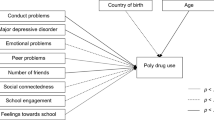Abstract
The current study examined the settings in which adolescents use alcohol and drugs, emphasizing sex and peer group differences in where substance use occurs, settings associated with more problematic substance use, and settings potentially serving as sites of initiation of adolescent substance use. Subjects were 449 juniors and seniors attending two Midwestern high schools (51% male; aged 16–19) who completed in-class surveys. Few sex differences in settings of substance use were found, although girls were more likely than boys to drink in family settings. More severe substance use was associated with a higher likelihood of drinking at school. Moreover, alcohol users were more likely to report drinking in their own homes and at their friends' homes than abstainers were to indicate selecting these settings to use alcohol if they were to do so. Drug users were more likely to report substance use outdoors, at their friends' homes, at social parties, and at school than were abstainers to indicate selecting these settings to use drugs if they were to do so. Implications of these findings for understanding the epidemiology of substance use and high-risk settings for the initiation and escalation of substance using behaviors are discussed.
Similar content being viewed by others
REFERENCES
Allison, K., Leone, P. E., and Spero, E. R. (1990). Drug and alcohol use among adolescents: Social context and competence. In Leone, P. E. (ed.), Understanding Troubled and Troubling Youth, Sage, Newbury Park, CA, pp. 173–193.
Bauman, K. E., and Ennett, S. T. (1994). Peer influence on adolescent drug use. Am. Psychol. 49: 820–822.
Brown, B. B. (1990). Peer groups and peer cultures. In Feldman, S. S., and Elliot, G. R. (eds.), At the Threshold: The Developing Adolescent, Harvard University Press, Cambridge, MA, pp. 171–196.
Brown, B. B., and Lohr, M. J. (1987). Peer-group affiliation and adolescent self-esteem: An integration of ego-identity and symbolic-interaction theories. J. Person. Soc. Psychol. 52: 47–55.
Brown, S. A. (1993). Recovery patterns in adolescent substance abuse. In Baer, J. S., Marlatt, G. A., and McMahon, R. J. (eds.), Addictive Behaviors Across the Life Span: Prevention, Treatment and Policy Issues, Sage, Newbury Park, CA, pp. 161–183.
Caswell, S., Zhang, J. F., and Wyllie, A. (1993). The importance of amount and location of drinking for the experience of alcohol-related problems. Addiction 88: 1527–1534.
Chassin, L. (1994). Adolescent substance use and abuse. In Karoly, P., and Steffen, J. J. (eds.), Adolescent Behavior Disorders:Foundations and Contemporary Concerns, Lexington Books, Lexington, MA, pp. 99–152.
Chassin, L., Rogosch, F., and Barrera, M. (1991). Substance use and symptomatology among children of alcoholics. J. Abnorm. Psychol. 100: 449–463.
Clark, W. B. (1985). Alcohol use in various settings. In Single, E., and Storm, T. (eds.), Public Drinking and Public Policy, Addiction Research Foundation, Toronto, pp. 49–70.
Connolly, G. M., Casswell, S., Stewart, J., and Silva, P. A. (1992). Drinking context and other influences on the drinking of 15 year-old New Zealanders. Br. J. Addict. 87: 1029–1036.
Curran, P. J., Harford, T., and Muthen, B. (1996). The relation between heavy alcohol use and bar patronage: A latent growth model. J. Stud. Alcohol 57: 410–418.
Donnermeyer, J. F., and Shik Park, D. (1995). Alcohol use among rural adolescents: Predictive and situational factors. Int. J. Addict. 30: 459–479.
Fine, G. A., Mortimer, J. T., and Roberts, D. F. (1990). Leisure, work and the mass media. In Feldman, S. S., and Elliot, G. R. (eds.), At the Threshold: The Developing Adolescent, Harvard University Press, Cambridge, MA, pp. 225–252.
Harford, T., and Spiegler, D. L. (1983). Developmental trends in adolescent drinking. J. Stud. Alcohol 44: 181–188.
Hosmer, D. W., and Lemeshow, A. (1989). Applied Logistic Regression, Wiley, New York.
Johnston, L. D., O'Malley, P. M., and Bachman, J. G. (1998). Monitoring the Future: Data Tables and Figures [on-line]. Available: http://www.isr.umich.edu/src/mtf.
Johnston, L. D., O'Malley, P. M., and Bachman, J. G. (1995). National Survey Results on drug use from the monitoring the future study, 1975–1994: Volume 1 secondary students (DHHS Publication No. 95-4026), U.S. Government Printing Office, Washington, DC.
Kandel, D. B. (1975). Stages in adolescent involvement in drug use. Science 190: 912–914.
Mayer, R. R., Forster, J. L., Murray, D. M., and Wagenaar, A. C. (1998). Social settings and situations of underage drinking. J. Stud. Alcohol 59: 207–215.
Mookherjee, H. N. (1984). Teenage drinking in rural middle Tennessee. J. Alcohol Drug Educ. 29: 49–57.
Sher, K. J. (1991). Children of Alcoholic Parents: A Critical Appraisal of Theory and Research, University of Chicago Press, Chicago.
Single, E., and Storm, T. (1985). Public Drinking and Public Policy, Addiction Research Foundation, Toronto.
Single, E., and Wortley, S. (1993). Drinking in various settings as it relates to demographic variables and level of consumption: Findings from a national survey in Canada. J. Stud. Alcohol 54: 590–599.
Smith, T. E., Koob, J., and Wirtz, T. (1985). Ecology of adolescents' marijuana abuse. Int. J. Addict. 20: 1421–1428.
Stacy, A.W., Widaman, K. F., Hays, R., and Dimatteo, M. R. (1985). Validity of self-reports of alcohol and other drug use: A multitrait-multimethod assessment. J. Person. Soc. Psychol. 49: 219–232.
Stoduto, G., Adlaf, E. M., and Mann, R. E. (1998). Adolescents, bush parties and drinking-driving. J. Stud. Alcohol 59: 544–548.
van der Goor, L. A. M., Knibbe, R. A., and Drop, M. J. (1990). Adolescent drinking behavior: An observational study of the influence of situational factors on adolescent drinking rates. J. Stud. Alcohol 51: 548–555.
Westermeyer, J. (1997). Substance-related disorders. In Ammerman, R. T., and Hersen, M. (eds.), Handbook of Prevention and Treatment with Children and Adolescents: Intervention in the Real World Context, John Wiley & Sons, New York, pp. 604–628.
Wills, T. A. (1986). Stress and coping in early adolescence; Relationships to substance use in urban school samples. Health Psychol. 5: 503–529.
Author information
Authors and Affiliations
Rights and permissions
About this article
Cite this article
Hussong, A.M. The Settings of Adolescent Alcohol and Drug Use. Journal of Youth and Adolescence 29, 107–119 (2000). https://doi.org/10.1023/A:1005177306699
Issue Date:
DOI: https://doi.org/10.1023/A:1005177306699




